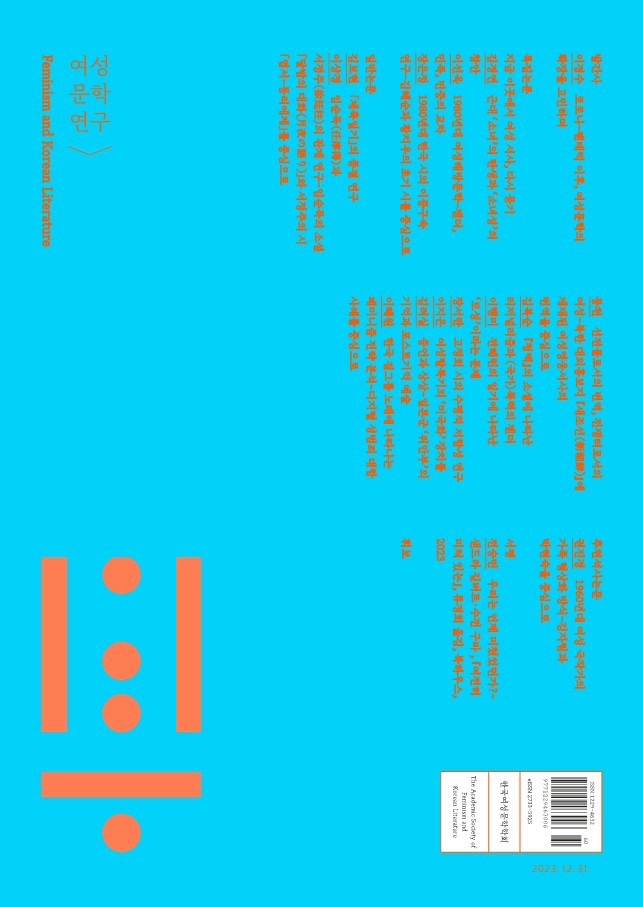- ENGLISH
- P-ISSN1229-4632
- E-ISSN2733-5925
- KCI
 ISSN : 1229-4632
ISSN : 1229-4632
상부하고 개가하는 여성들의 서사 –〈변강쇠가〉와 〈덴동어미화전가〉를 중심으로
The Narrative of Repeating Bereavement and Remarriage –Revisiting Byeongangsoega and Dendongeomiwhajeonga
초록
〈변강쇠가〉와 〈덴동어미화전가〉는 여성의 거듭된 상부(喪夫)와 개가(改嫁)의 서사를 포함한다는 점에서 여러 차례 함께 논의되어왔다. 본고는 옹녀와 덴동어미의 서사에서 발견되는 차이를 각 인물의 성격 문제로 환원하거나 그 차이의 우열을 나누는 시각을 지양하고, 두 여성인물의 서사를 다각적으로 살피며 비교 연구의 시각을 심화해보고자 하였다. 우선 이 여성들의 이야기가 배치되는 텍스트의 전체 구성을 살펴볼 경우, 〈변강쇠가〉가 이전에도 반복되어 왔으며 앞으로도반복될 옹녀의 개가와 상부의 서사 가운데 강쇠와의 만남을 중심으로 한 부분을떼어내어 조명한다면, 〈덴동어미화전가〉는 화전놀이의 현장에서 발생한 문제를덴동어미가 해결한다는 맥락 안에 덴동어미의 상부와 개가의 서사를 배치하고있다. 한편 〈변강쇠가〉의 경우 결말에서 옹녀를 외따로 남겨둔 채 그 행방을 묘연하게 처리하는데, 이는 서술자의 논평으로조차 충분히 봉합되지 않는 불편감을 가중시킨다. 이에 반해 〈덴동어미화전가〉는 화전놀이 현장에서 발생한 문제가 덴동어미의 발화를 통해 해결됨을 드러냄으로써, 모두가 조화롭게 어우러지는 공동체 전체의 흥겨움을 고조시키며 마무리된다. 미결의 감각을 남기는 〈변강쇠가〉와 만족스러운 종결의 감각을 남기는 〈덴동어미화전가〉의 차이는, 어떠한공동체에도 포용되지 못하는 옹녀와 고향의 관계망에 연결되어 있는 덴동어미가 처한 조건 간의 차이와도 연관된다. 이로써 〈변강쇠가〉와 〈덴동어미화전가〉 는 공동체의 구성적 성격을 각기 다른 각도로 사유하게끔 추동한다. 공동체의 안과 밖, 그 경계의 폐쇄성과 유동성 사이를 오가도록 만든다는 점에서 두 텍스트는 함께 읽을 때 그 의미망이 보다 확장되는바, 이는 곧 비교 연구의 새로운 의의라고도 볼 수 있다.
- keywords
- Byeongangsoega, Dendongeomiwhajeonga, Ongnyeo, Dendong-eomi, bereavement, remarriage, community, harmony, discomfort, ending, 변강쇠가, 덴동어미화전가, 옹녀, 덴동어미, 상부, 개가, 공동체, 결말
Abstract
Byeongangsoega and Dendongeomiwhajeonga are juxtaposed due to their similar narrative involving a female character who experiences the repeated loss of her husband and subsequent involvement with a new partner. This study focuses on the narratives of Ongnyeo in Byeongangsoega and Dendong-eomi in Dendongeomiwhajeonga, and compares them from a new angle, moving beyond hierarchical evaluations of them and considering more various dimensions. First, an examination of the women’s relationships with their respective communities shows that the disparities between Ongnyeo and Dendong-eomi do not stem solely from their respective “inclinations” but are closely tied to the “conditions” that contextualize them. Their conditions are intricately intertwined with the aesthetics of the text as well: the aesthetics of discomfort in Byeongangsoega and the aesthetics of harmony in Dendongeomiwhajeonga. It is because these aesthetics are closely linked to whether a female character who experiences the repeated loss of her husband and then remarries—in other words, one who deviates from the social norms of the late Joseon period—is excluded from the community or not. Building upon this analysis, this study seeks to reposition Byeongangsoega and Den dongeomiwhajeonga as significant sites for contemplating the literary representation of the boundary of the community.
- keywords
- Byeongangsoega, Dendongeomiwhajeonga, Ongnyeo, Dendong-eomi, bereavement, remarriage, community, harmony, discomfort, ending, 변강쇠가, 덴동어미화전가, 옹녀, 덴동어미, 상부, 개가, 공동체, 결말
- 다운로드 수
- 조회수
- 0KCI 피인용수
- 0WOS 피인용수
